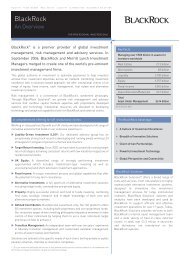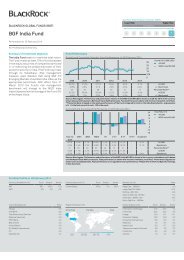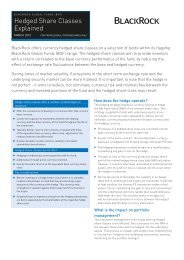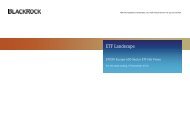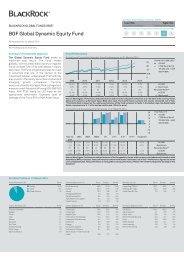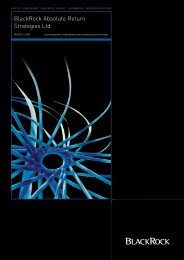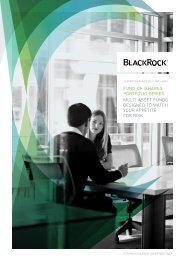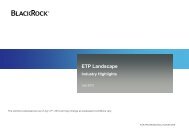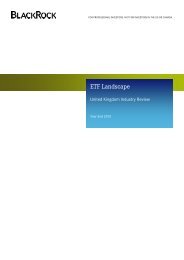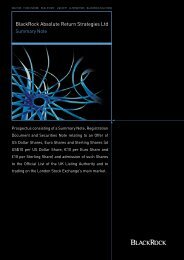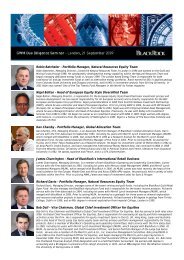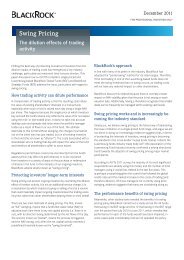ETF Landscape: Celebrating 10 Years of ETFs in Europe - BlackRock
ETF Landscape: Celebrating 10 Years of ETFs in Europe - BlackRock
ETF Landscape: Celebrating 10 Years of ETFs in Europe - BlackRock
- No tags were found...
You also want an ePaper? Increase the reach of your titles
YUMPU automatically turns print PDFs into web optimized ePapers that Google loves.
<strong>ETF</strong> <strong>Landscape</strong> April 20<strong>10</strong><strong>Celebrat<strong>in</strong>g</strong> <strong>10</strong> <strong>Years</strong> <strong>of</strong> <strong>ETF</strong>s <strong>in</strong> <strong>Europe</strong> from <strong>BlackRock</strong><strong>Celebrat<strong>in</strong>g</strong> <strong>10</strong> <strong>Years</strong> <strong>of</strong> <strong>ETF</strong>s <strong>in</strong> <strong>Europe</strong>This special edition <strong>of</strong> <strong>ETF</strong> <strong>Landscape</strong> is <strong>BlackRock</strong>’s comprehensive report on the history and outlook for the <strong>ETF</strong> <strong>in</strong>dustry <strong>in</strong><strong>Europe</strong>. The report covers Exchange Traded Funds (<strong>ETF</strong>s) and Exchange Traded Products (ETPs). <strong>ETF</strong>s are open-end <strong>in</strong>dex fundsthat provide daily portfolio transparency, are listed and traded on exchanges like stocks on a secondary basis as well as utilis<strong>in</strong>g aunique creation and redemption process for primary transactions. ETPs are products that have similarities to <strong>ETF</strong>s <strong>in</strong> the way theytrade and settle but they do not use a mutual fund structure. The use <strong>of</strong> other structures <strong>in</strong>clud<strong>in</strong>g grantor trusts, partnerships,notes and commodity pools by ETPs can create different tax and regulatory implications for <strong>in</strong>vestors when compared to <strong>ETF</strong>s,which are funds. This commentary should not be regarded as a research report 1 .April 20<strong>10</strong> marks the <strong>10</strong>th anniversary <strong>of</strong>the launch <strong>of</strong> the first Exchange TradedFunds (<strong>ETF</strong>s) <strong>in</strong> <strong>Europe</strong>We take this opportunity to reflect on the history <strong>of</strong> <strong>ETF</strong>s as well asconsider the outlook for the future <strong>of</strong> <strong>ETF</strong>s <strong>in</strong> <strong>Europe</strong>.HighlightsThe rate <strong>of</strong> growth <strong>in</strong> terms <strong>of</strong> assets, number <strong>of</strong> products, list<strong>in</strong>gs,exchanges and providers has been greater <strong>in</strong> <strong>Europe</strong> than theexperience <strong>of</strong> <strong>ETF</strong>s <strong>in</strong> the early years <strong>in</strong> the US. Over the pastdecade through year end 2009 the compound annual growth ratefor <strong>ETF</strong> assets globally was 56.3%, it was 58.1% <strong>in</strong> the United States,53.1% <strong>in</strong> Canada and 90.5% <strong>in</strong> <strong>Europe</strong>, and there are no signs that<strong>in</strong>vestor <strong>in</strong>terest <strong>in</strong> <strong>ETF</strong>s is fad<strong>in</strong>g. Investors are f<strong>in</strong>d<strong>in</strong>g that <strong>ETF</strong>s areproducts that work well <strong>in</strong> every market environment.Exchange Traded Funds have become popular and widely used<strong>in</strong>vestment vehicles. In a world where <strong>in</strong>vestment products comeand go with the bl<strong>in</strong>k <strong>of</strong> an eye, <strong>ETF</strong>s might be considered one <strong>of</strong>the most <strong>in</strong>novative f<strong>in</strong>ancial products <strong>in</strong> the last two decades. Theyhave fundamentally changed how both <strong>in</strong>stitutional and retail<strong>in</strong>vestors construct their <strong>in</strong>vestment portfolios.<strong>ETF</strong>s have opened a new panorama <strong>of</strong> <strong>in</strong>vestment opportunities.Essentially, <strong>ETF</strong>s are <strong>in</strong>dex funds that are listed and traded onexchanges like stocks, allow <strong>in</strong>vestors to ga<strong>in</strong> broad exposure tospecific segments <strong>of</strong> equity, fixed <strong>in</strong>come, and commodity marketswith relative ease, on a real-time basis, and at a lower cost thanmany other forms <strong>of</strong> <strong>in</strong>vest<strong>in</strong>g. <strong>ETF</strong>s are based on sector, large-cap,mid-cap, small-cap, value, growth, domestic, <strong>in</strong>ternational countryand regional equity <strong>in</strong>dices, commodities and currencies as well ason corporate, credit, <strong>in</strong>flation and government fixed <strong>in</strong>come <strong>in</strong>dices.<strong>ETF</strong>s typically can be used to short <strong>in</strong>dices, are lendable, and arepurchased on a commission basis just like other equities.<strong>ETF</strong>s <strong>of</strong>fer many advantages. We believe that growth <strong>in</strong> the use <strong>of</strong><strong>ETF</strong>s reflects their many advantages. They trade throughout the dayon major securities exchanges and can be bought and sold us<strong>in</strong>gmarket, limit, or stop orders. <strong>ETF</strong>s are funds, not derivatives, whichallow <strong>in</strong>vestors to quickly react to short and long-term needs oropportunities. As such, they may serve as an alternative to futures,trad<strong>in</strong>g baskets <strong>of</strong> stocks and traditional mutual funds. <strong>ETF</strong>s do nothave any sales loads, although they do, like mutual funds, haveannual expense ratios, albeit less than traditional funds, rang<strong>in</strong>gfrom zero to 1.81%. In fact, <strong>ETF</strong>s have some <strong>of</strong> the lowest expenseratios among registered <strong>in</strong>vestment products. Recent <strong>in</strong>terest from<strong>in</strong>vestors has been partially fuelled by attempts to avoid account<strong>in</strong>g,earn<strong>in</strong>gs, and other stock-specific risks.<strong>ETF</strong>s are <strong>in</strong>dex-based 2 open-ended funds that can be bought andsold as quickly and easily as ord<strong>in</strong>ary shares on a stock exchange –they have become popular and widely used <strong>in</strong>vestment vehicles toachieve many <strong>in</strong>vestment strategies: To ga<strong>in</strong> diversified exposure to a market For core/satellite <strong>in</strong>vest<strong>in</strong>g. For buy and hold <strong>in</strong>vest<strong>in</strong>g. For active traders who wish to take advantage <strong>of</strong>market movements. For <strong>in</strong>vestors wish<strong>in</strong>g to hedge the market. As an alternative to futures and other <strong>in</strong>stitutional<strong>in</strong>vestment tools.<strong>Europe</strong>an <strong>ETF</strong> statistical update(end <strong>of</strong> January 20<strong>10</strong>) 3 At the end <strong>of</strong> January 20<strong>10</strong> the <strong>Europe</strong>an <strong>ETF</strong> <strong>in</strong>dustry had 896<strong>ETF</strong>s with 2,468 list<strong>in</strong>gs, assets <strong>of</strong> US$217.9 Bn, from 34providers on 18 exchanges. YTD assets have decreased by 4.0%, which is less than the 5.9%fall <strong>in</strong> the MSCI <strong>Europe</strong> Index <strong>in</strong> US dollar terms. The top 50 <strong>ETF</strong>s, out <strong>of</strong> 896, account for 52.6% <strong>of</strong> <strong>Europe</strong>an<strong>ETF</strong> AUM. The top <strong>10</strong>0 <strong>ETF</strong>s, out <strong>of</strong> 896, account for 69.5% <strong>of</strong> <strong>Europe</strong>an<strong>ETF</strong> AUM. There are 181 <strong>ETF</strong>s <strong>in</strong> <strong>Europe</strong> with less than US$<strong>10</strong>.0 Mn<strong>in</strong> assets. YTD the number <strong>of</strong> <strong>ETF</strong>s <strong>in</strong>creased by 8.1% with 67 new<strong>ETF</strong>s launched. YTD the number <strong>of</strong> exchanges with <strong>of</strong>ficial list<strong>in</strong>gs rema<strong>in</strong>s at 18. YTD the average daily trad<strong>in</strong>g volume <strong>in</strong> US dollars <strong>in</strong>creased by24.5% to US$2.8 Bn. Most <strong>ETF</strong> trades are not required to bereported <strong>in</strong> <strong>Europe</strong> as <strong>ETF</strong>s are not covered by the <strong>Europe</strong>anUnion Directive on Markets <strong>in</strong> F<strong>in</strong>ancial Instruments (MiFID). The top three <strong>ETF</strong> providers, out <strong>of</strong> 34, have 74% market share. iShares is the largest provider <strong>of</strong> <strong>ETF</strong>s <strong>in</strong> <strong>Europe</strong> <strong>in</strong> terms <strong>of</strong> bothnumber <strong>of</strong> products, 172, and AUM <strong>of</strong> US$82.5 Bn, reflect<strong>in</strong>g37.9% market share; Lyxor Asset Management is second with127 products and US$43.8 Bn, a 20.1% market share.db x-trackers is third with 118 products and assets <strong>of</strong>US$35.8 Bn and a 16.4% market share.1. Certa<strong>in</strong> terms used <strong>in</strong> this publication may differ from those applied by other <strong>in</strong>dustry participants.2. Most are <strong>in</strong>dex-based, but some are active.3. Source: Various <strong>ETF</strong> providers, exchanges, Global <strong>ETF</strong> Research and Implementation Strategy Team, <strong>BlackRock</strong>, Bloomberg data as at 29 January 20<strong>10</strong>.This document is not an <strong>of</strong>fer to buy or sell any security or to participate <strong>in</strong> any trad<strong>in</strong>g strategy. Please refer to important <strong>in</strong>formation and qualifications at the end <strong>of</strong> this material. 2



